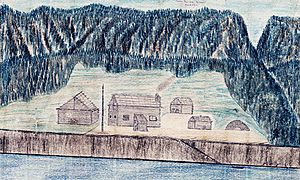Fort Reliance facts for kids
Fort Reliance was an old trading post in the Yukon Territory of Canada. It was built on the east side of the Yukon River, about 13 kilometers (8 miles) downstream from the town of Dawson City. This fort was started in 1874 by François Mercier, Jack McQuesten, and Francis Barnfield. They worked for the Alaska Commercial Company and set up the fort as a place for trading goods.
Trading at Fort Reliance happened regularly until 1877. During this time, the post became a very important spot for traders. Rivers like the Fortymile River, Sixtymile River, and Seventymile River got their names from how far away they were from the fort.
In 1877, traders left the fort after some of their goods were stolen. But they came back in 1879 and kept the fort running until 1886. It was then abandoned because gold was found on the Stewart River. The gold discovery made traders focus on finding gold instead of trading furs, so the fort became less important.
History of Fort Reliance
Fort Reliance was first built as a place to trade furs with the local Han Native people. François Mercier chose the spot for the fort. Jack McQuesten and Francis Barnfield, with help from the Han natives, built it.
After the fort was built, McQuesten and Barnfield started trading with the natives. They traded all their goods for valuable furs. The first year showed that the fort could make a lot of money. Fort Reliance became a major trading center in the area.
However, in 1877, the traders left the fort because some of their goods were stolen by Han natives. Jack McQuesten returned to the fort in 1879. He wanted to avoid competition from other trading posts further down the river.
A chief from a nearby tribe warned McQuesten not to go back. After the fort was left empty, a misunderstanding happened involving some leftover supplies that caused harm to some native women. The chief worried about McQuesten's safety if he returned.
But McQuesten decided to go to Fort Reliance anyway. He found that the Han natives actually welcomed him back. They even gave him things to make up for the goods that were stolen earlier. They did not blame the traders for what had happened.
The fort continued to be used for trading furs. Over time, it also became a place where gold prospectors on the Yukon River could stop for supplies. When gold was discovered on the Stewart River, which flows into the Yukon River downstream from Fort Reliance, trade moved away from the fort. Because of this, Fort Reliance was finally abandoned.
Buildings at the Fort
Fort Reliance had several buildings made in different ways. Today, all that is left of these buildings are marks on the ground, like pits or holes where posts once stood. After the fort was abandoned, many of its buildings were used as fuel for steamboats traveling on the Yukon River.
The main buildings were three or four log cabins built for the traders. The biggest cabin was described by François Mercier as being about 7.6 meters (25 feet) long and 9.1 meters (30 feet) wide.
You can also find the remains of five pit houses at the site. These pits were roughly 4.5 to 5 meters (15 to 16 feet) square. Four of them had dug-out entrances that were between 2.5 and 5 meters (8 to 16 feet) long. These pit houses were likely where the Han natives who traded at the fort lived.
Native Han People
The area where Fort Reliance was built shows signs that the Native Han people lived there even before the fort was established. They also lived there while the fort was open for trade.
The remains of a Han fishing village, called Nuclaco, are on a small island near the west side of the Yukon River. This is just across from the fort. The Han people used this site seasonally during the summer. This was when king and chum salmon swam upstream.
Population Information
| Historical population | |||
|---|---|---|---|
| Census | Pop. | %± | |
| 1880 | 83 | — | |
In 1880, Fort Reliance was mistakenly listed in the United States Census as being in Alaska. However, it was actually about 80 kilometers (50 miles) east of the international border, in Canada. The census showed that 83 people lived there. One person was White, and 82 people belonged to the Tinneh tribe.


